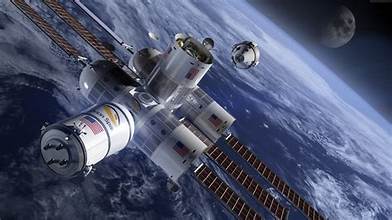Space tourism, once a concept confined to science fiction, has become a tantalizing reality in the modern era. This groundbreaking industry promises to take ordinary individuals beyond Earth’s atmosphere, providing experiences that were once reserved for astronauts. As private companies make space travel accessible, the dream of witnessing the cosmos firsthand is closer than ever before.
The Origins of Space Tourism: From Dream to Reality
The journey of space tourism began with humanity’s fascination with the stars, inspiring scientific exploration and technological innovation. Early space missions were conducted by governments, focusing on research, national pride, and scientific advancement. However, the idea of sending civilians to space was a distant vision.
This vision took its first step toward reality in 2001 when Dennis Tito, the first space tourist, visited the International Space Station. His journey, facilitated by Russia’s Soyuz program, marked the dawn of commercial space travel. This event inspired private companies to explore the commercial potential of space tourism, igniting a new era in human exploration.
The Role of Private Companies in Shaping Space Tourism
Private aerospace companies have played a pivotal role in transforming space tourism from a niche concept into a burgeoning industry. Firms like SpaceX, Blue Origin, and Virgin Galactic have invested heavily in developing reusable spacecraft, reducing costs and increasing accessibility.
Virgin Galactic has focused on suborbital flights, offering passengers a brief but exhilarating journey to the edge of space. Blue Origin, led by Jeff Bezos, has emphasized comfort and safety with its New Shepard spacecraft. SpaceX, under Elon Musk’s leadership, has pushed boundaries with plans for orbital and lunar tourism.
These companies have democratized space travel, making it possible for civilians to experience the wonders of space. Their advancements have fueled competition and innovation, driving the industry toward an exciting future.
The Space Tourism Experience: What Awaits Travelers?
A space tourism experience offers breathtaking views, weightlessness, and the profound realization of Earth’s place in the cosmos. Before embarking on a journey, travelers undergo rigorous training to prepare for the physical and psychological demands of space travel. This preparation ensures their safety and comfort during the adventure.
The journey begins with a launch into orbit, providing unparalleled views of Earth from space. Passengers experience microgravity, floating freely in the spacecraft and marveling at the boundless universe. Depending on the mission, travelers may participate in scientific experiments or simply enjoy the awe-inspiring environment.
Space tourism offers a unique opportunity to see Earth from a perspective that few have witnessed. The vivid contrast between the planet’s vibrant colors and the dark expanse of space leaves travelers with an enduring sense of wonder.
Technological Innovations Driving Space Tourism
The rapid advancements in aerospace technology have made space tourism safer, more affordable, and more sustainable. Reusable rockets, pioneered by companies like SpaceX, have significantly reduced the cost of space travel, making it accessible to a wider audience.
Innovations in spacecraft design prioritize passenger comfort and safety, incorporating features like pressurized cabins, advanced life support systems, and emergency protocols. Spacecraft are now equipped with cutting-edge navigation systems, ensuring precise and reliable journeys.
These technological breakthroughs enable longer missions, such as lunar tourism, and pave the way for future developments. With ongoing research and investment, space tourism continues to evolve, pushing the limits of human exploration.
The Environmental Impact of Space Tourism
Space tourism’s environmental impact has sparked debates about its sustainability and the ethical implications of commercial space travel. Rocket launches emit significant amounts of carbon dioxide and other greenhouse gases, contributing to climate change. The frequency of launches must be carefully managed to minimize their environmental footprint.
Efforts are underway to develop eco-friendly propulsion systems, such as methane-based engines and hybrid rockets. These innovations aim to reduce emissions and create a more sustainable approach to space travel. Additionally, private companies are exploring carbon offset programs to address their environmental impact.
Balancing the desire for space exploration with environmental responsibility remains a crucial challenge for the space tourism industry.
Space Tourism’s Role in Scientific Research
Space tourism contributes to scientific research by supporting experiments and data collection in microgravity environments. Private space missions provide opportunities to study biological, physical, and chemical phenomena that cannot be replicated on Earth. These studies have practical applications in medicine, materials science, and engineering.
Space tourists themselves can participate in research activities, such as monitoring physiological changes during spaceflight. The data collected enhances our understanding of the human body’s response to space travel, informing future missions and advancing medical knowledge.
By merging tourism with science, the industry fosters collaboration between commercial entities and research institutions, driving innovation and discovery.
Economic Opportunities Created by Space Tourism
The rise of space tourism has created economic opportunities, generating jobs and driving innovation across multiple sectors. The industry requires skilled professionals, including engineers, technicians, and researchers, to design, build, and operate spacecraft.
Tourism-related infrastructure, such as spaceports and training facilities, stimulates local economies and attracts investments. Space tourism also inspires technological advancements that have broader applications, boosting industries like telecommunications, transportation, and renewable energy.
As the industry expands, it creates a ripple effect of economic growth, positioning space tourism as a key driver of the global economy in the coming decades.
Space Tourism and the Future of Human Exploration
Space tourism serves as a stepping stone for humanity’s broader exploration of the solar system and beyond. By normalizing space travel, the industry fosters innovation and public interest in space exploration. This momentum supports ambitious missions to Mars, asteroid mining, and interplanetary colonization.
The development of lunar tourism offers insights into living and working in extraterrestrial environments, paving the way for sustainable human presence on other celestial bodies. These advancements bring humanity closer to achieving its dream of becoming a multiplanetary species.
Space tourisms symbolizes the spirit of discovery, inspiring generations to push boundaries and explore the unknown.
Challenges Facing the Space Tourism Industry
Despite its promise, space tourisms faces challenges that must be addressed to ensure its long-term viability. High costs remain a barrier, limiting access to affluent individuals and slowing market growth. Developing cost-effective technologies is essential to make space tourisms accessible to a wider audience.
Safety concerns are paramount, as space travel involves inherent risks. Ensuring reliable systems and robust training programs mitigates these risks, fostering public trust in the industry. Regulatory frameworks must also evolve to address the unique challenges of commercial space travel, including liability, airspace coordination, and environmental protection.
Resolving these challenges requires collaboration among governments, private companies, and international organizations.
FAQs
How much does a space tourism trip cost?
Space tourism trips currently range from hundreds of thousands to millions of dollars, depending on the mission and provider.
Is space tourism safe for ordinary individuals?
While space tourisms involves risks, rigorous training and advancements in spacecraft technology prioritize safety for all participants.
How long do space tourism trips typically last?
Suborbital flights last a few minutes, while orbital missions can extend for several days, depending on the itinerary.
Can space tourists participate in scientific experiments?
Yes, some missions include opportunities for space tourists to engage in scientific experiments and contribute to research efforts.
What impact does space tourism have on the environment?
Rocket launches contribute to greenhouse gas emissions, but efforts are underway to develop eco-friendly propulsion systems and offset programs.
Will space tourism become more affordable in the future?
As technology advances and competition increases, the cost of space tourisms is expected to decrease, making it more accessible.
Conclusion
Space tourisms represents a transformative leap in human ambition, enabling ordinary individuals to experience the extraordinary wonders of the cosmos. Through technological innovation, collaboration, and determination, this burgeoning industry has overcome significant challenges, paving the way for a new era of exploration and adventure. As space tourisms continues to evolve, it promises to inspire humanity to dream bigger, explore further, and connect more deeply with the universe we call home.











